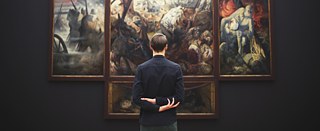The Elite in the Arts | Literature
Poetic Populism In and Beyond the Novel

The chart reflects multiple relations between populism and elites in literature: while the “good people” were initially popular, among the aesthetic elite as well, the Nazi period represents a change, bringing ideological populism to the fore. After 1945, this led to more elitist tendencies in literature.
Literature relates to elites as well as to the people in manifold ways: Authors tend to criticize the masses and the elites (including their peers) in order to prove their artistic and reflected distance to the outer world.
Inspired by an idealized view of the people dating back to eighteenth and nineteenth-century social criticism, authors and intellectuals around 1900 contrasted the “good people” with the “bad elite” – the bosses and businessmen. This “bad elite” was supposed to be overcome by a self-proclaimed anti-bourgeois and aesthetic elite, sometimes called the “avant-garde.” As a best-selling genre, the novel – for instance Thomas Mann’s Buddenbrooks (1901) – could serve as the medium in which most of these conflicts were depicted openly and exerted their political impact. This was also true of Alfred Döblin’s Berlin Alexanderplatz (1929), a novel about a laborer that provoked right-wing as well as left-wing intellectuals to discuss this type of critical yet popular writing.

Among the ultra-conservative and later Nazi writers, Erwin Guido Kolbenheyer, for instance, created what he regarded as an original mythology of the German people: Bedeviled by religious fragmentation, the Germans search for the meaning of things on their own and fight the elitist intellectualism that originated around the Mediterranean. Characterized by their “Faustian” soul, the Germans explore uncharted territory in order to reach, in the end, a peaceful existence. In his novel Paracelsus, Kolbenheyer unfolds these ideas and sanctifies them through fictional talks between the Nordic God Wotan and Jesus Christ. Kolbenheyer did not confine the expression of his views to literature; he also supported the Nazi movement in public speeches.
Among the elitist works of the post-war period is Zettels Traum by Arno Schmidt (1970), a complex and witty, but hard to understand opus of eight volumes. Alluding to Shakespeare’s Midsummer Night’s Dream, Schmidt’s novel takes place in the summer of 1968 and is a tour de force of literary history combined with psychoanalysis.
The future remains open. As a debate in 2018 between the authors Durs Grünbein and Uwe Tellkamp has shown, far-right wing publishers are trying to sell their works at book fairs, and the ideological debate about literary populism is back on the agenda.
To the Overview